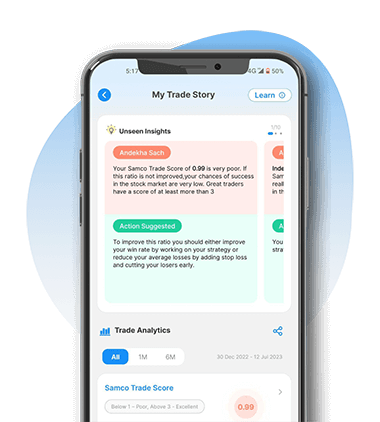In this article, we will discuss
- What is the Protective Call?
- The Time Frame for Short Selling in India
- How to Implement the Protective Call Strategy?
- The Protective Call: An Example
- Pros and Cons of the Protective Call
- Evaluate the Protective Call Thoroughly with Samco Securities Limited
One of the primary advantages of options contracts is that they can help you hedge or offset the risk in other positions in the market. In fact, options are primarily considered as hedging instruments as opposed to speculative instruments. Beginners in the options market can make use of these derivatives to hedge their positions in the cash segment using protective options strategies.
One such risk-limiting and potentially profitable options trading strategy is the protective call. Check out what this strategy entails, how to set it up and what its possible outcomes are.
What is the Protective Call?
The protective call is a risk mitigation strategy that is implemented to protect you against unexpected upward price movement of the underlying stock. Also known as the married call or the synthetic put, it is best implemented when you expect the price of the stock to fall and therefore short-sell that stock in the market. To protect against unexpected losses if the price rises instead, you also purchase a call option with the stock as the underlying.
If the stock price falls as expected, your call option expires worthless but you profit from the short-sold stock. However, if the stock price rises instead, the profits from the long call option can set off the losses from the short-sold stock.
The Time Frame for Short Selling in India
Short selling of stocks in the spot market is allowed in India. However, such short positions are only permitted on an intraday basis. This means that short positions must be squared off by the end of the trading day and cannot be carried forward to the next trading session.
So, if you are planning to execute a protective call to protect your short position in an underlying stock, you need to ensure that the time frames for both trades are well-aligned. You can either select call options that expire on the same day or you could square off your options position by the end of the trading day to ensure that the strategy remains effective within the limited time frame. This alignment maintains the protective nature of the strategy without extending risk exposure beyond a single trading day.
Alternatively, if you choose to execute the protective call for a short position in the futures market, this issue does not arise because there is no restriction on the time frame. So, you can buy a protective call on your short futures position with any appropriate expiry date — even if it is not the same as the futures expiry. However, ensure that you square off the options position on or before the expiry to optimise the outcomes.
How to Implement the Protective Call Strategy?
To implement the protective call, you only need to purchase a call option to secure your short trade. Let us decode the steps required to make this options trading strategy profitable.
-
Initiate the Short Trade
Identify the stock that you expect will be bearish by the end of the trading day and initiate a short sale in that stock. Since you have an ultra-short-term horizon, you can rely on technical analysis, candlestick charts and other technical indicators to filter stocks that have a high probability of declining in price during the intraday session.
Alternatively, you can choose to open a short trade in the futures market as well. Here, the time frame will be longer because there is no intraday restriction on short-selling in the futures market.
-
Buy a Protective Call
The stock or the futures contract you shorted may have a high chance of being bearish over the period during which the position is open, but the market is unpredictable. So, it is also probable that the stock or futures price may rise during the period. In that case, the short sale will turn out to be a loss-making position. To protect yourself against this risk, you can implement the protective call strategy and purchase a call option with the same stock or futures contract as the underlying asset.
This call option can be an at-the-money (ATM) or slightly out-of-the-money (OTM) contract. The choice between the two depends on how much downside risk you are willing to tolerate and how much you are willing to pay to secure your short trade. An ATM option will be more expensive than an OTM option. However, if the options are closer to expiry, they will generally start to get less expensive due to the effect of time decay. You can take all these factors into account and choose a strike price that aligns with your risk tolerance and your budget.
The Protective Call: An Example
Consider the following hypothetical situation to better understand how the protective call works. Say you are bearish on a company’s stock and expect it to fall by the end of the trading day because of various financial triggers. So, you short 100 shares of that company when they are trading at Rs. 400 each.
Nevertheless, you also notice a strong support level on the chart, indicating that the price may rebound upward instead. So, to protect your short position against any potential upsides, you go ahead and purchase a call option. Let’s assume you are comfortable risking around 1% of your capital over the intraday session and can withstand an upswing up to Rs. 404.
This means you must purchase a call option with a strike price of Rs. 404. Now, say each call option has a lot size of 100 shares and costs Rs. 3.30 per share. To execute the protective call and protect yourself from a price increase, you need to purchase one lot (or 100 shares) at a total premium of Rs. 330 (i.e. Rs. 3.30 x 100 shares per lot).
To summarise:
Stock short-selling price = Rs. 400 per share
Number of stocks short-sold = 100 shares
Call option strike price = Rs. 404
Lot size = 100 shares
Premium paid = Rs. 3.30 per share or Rs. 330 in total
-
Scenario 1: The Stock Price Falls During the Trading Day
If your bearish outlook proves to be accurate, the stock price should decline during the trading day. Let’s assume this happens and the stock price dips from Rs. 400 to 395. In that case, the call option with a strike price of Rs. 404 expires worthless and you lose the premium paid. But the short position will turn out to be profitable, leading to the following overall outcome.
The Outcome of the Short Position:
= [(Short-Selling Price — Spot Price) x 100 shares] — Total Premium Paid
= [(Rs. 400 — Rs. 395) x 100 shares] — Rs. 330
= Rs. 500 — Rs. 330
= Rs. 170 profit
-
Scenario 2: The Stock Rises During the Trading Day
Now, let’s say the stock price rises unexpectedly during the day — from Rs. 400 to Rs. 412. In this case, the short trade that you initiated will result in a loss of Rs. 12 per share (i.e. Rs. 412 — Rs. 400). The total loss from this short position is Rs. 1,200 for 100 shares.
Without the protective call, this would be the total outcome of the trade. However, since you have a profitable position in the long call, your overall loss can be offset easily. The gains from the call option can be calculated as follows:
The Outcome of the Long Call:
= [(Spot Price — Strike Price) x 100 shares] — Total Premium Paid
= [(Rs. 412 — Rs. 404) x 100 shares] — Rs. 330
= Rs. 800 — Rs. 330
= Rs. 470 profit
This offsets the earlier loss and reduces it to Rs. 730 (i.e. Rs. 1,200 — Rs. 470).
Pros and Cons of the Protective Call
To make this options trading strategy profitable, you need to be aware of its advantages and limitations. Check out these details below.
The protective call can be beneficial because:
- Potential to earn profits (or to offset losses) if the stock price rises
- Limited downside risk
- Flexibility to select the strike price as per your risk tolerance levels
However, you must be aware of the following potential limitations:
- The extra cost of purchasing the call option
- Limited one-day time frame because of restrictions on short-selling time frames
Evaluate the Protective Call Thoroughly with Samco Securities Limited
The protective call is a simple hedging strategy. However, since it is combined with a short position in the underlying asset, timing is crucial. Short positions in the equity segment have an ultra-short-term outlook in the Indian securities market, so your protective call must be timed nearly perfectly.
To make this options trading strategy profitable, you need a host of analytical tools and insights — all of which are available to customers of Samco Securities Limited. By signing up for the brokerage firm’s demat and trading account, you can benefit from the Andekha Sach or hidden insights offered on the Samco trading app. Furthermore, you can also make your options trading strategy more profitable and effective using Options B.R.O. — a proprietary industry-first options strategy builder from Samco Securities Limited.
In addition to this, you can also make use of the Samco option calculator to assess how the value of the options contract in a protective call (or any other strategy) changes as the underlying asset’s price moves. This can help you judge the upside and the downside of your trade and make informed decisions based on real data.
Disclaimer: INVESTMENT IN SECURITIES MARKET ARE SUBJECT TO MARKET RISKS, READ ALL THE RELATED DOCUMENTS CAREFULLY BEFORE INVESTING. The asset classes and securities quoted in the film are exemplary and are not recommendatory. SAMCO Securities Limited (Formerly known as Samruddhi Stock Brokers Limited): BSE: 935 | NSE: 12135 | MSEI- 31600 | SEBI Reg. No.: INZ000002535 | AMFI Reg. No. 120121 | Depository Participant: CDSL: IN-DP-CDSL-443-2008 CIN No.: U67120MH2004PLC146183 | SAMCO Commodities Limited (Formerly known as Samruddhi Tradecom India Limited) | MCX- 55190 | SEBI Reg. No.: INZ000013932 Registered Address: Samco Securities Limited, 1004 - A, 10th Floor, Naman Midtown - A Wing, Senapati Bapat Marg, Prabhadevi, Mumbai - 400 013, Maharashtra, India. For any complaints Email - grievances@samco.in Research Analysts -SEBI Reg.No.-INHO0O0005847






Leave A Comment?